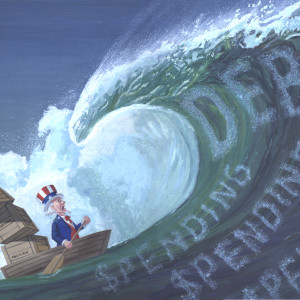Last month, Americans celebrated Independence Day—the day the Continental Congress formally adopted the Declaration of Independence and announced the 13 American colonies regarded themselves as sovereign states no longer part of the British Empire and subject to its rules and taxes.
In the years since 1776, the United States has become its own empire, and the costs of citizenship this year were not paid until July 6. From January 1 until two days after the July 4 Independence Day celebrations, Americans worked to earn enough income to cover the full costs of federal, state, and local governments, according to Americans for Tax Reform’s “Cost of Government Day” report.
In other words, only last month did we Americans start working for ourselves.
ATR each year determines Cost of Government Day by estimating how much national production goes to cover federal, state, and local spending and regulatory compliance costs. The Cost of Government Day estimate this year says we toiled 121 days to generate enough to cover government spending (including budget deficits) and another 65 days to cover the costs of regulations. This comes to slightly more than half of all economic production.
Cost of Government Day differs from similar reports, such as the Tax Foundation’s well-known Tax Freedom Day, by totaling all major costs of government and measuring them against the nation’s gross domestic output. Tax Freedom Day (which was April 21 this year) measures incomes and estimates the date by which an average American has earned enough money to pay the year’s taxes. That measure does not include the costs of regulatory burdens that get built into prices, or deficit spending that enables governments to grow far beyond tax revenues.
As bad as July 6 for Cost of Government Day sounds, this is actually an improvement on what we had a few years ago. The latest dates on record were July 21 in 2009 and 2010. State and local government spending cuts, a stronger economy since coming out of the financial crisis of 2008, and federal spending controls such as those imposed by the budget “sequester” three years ago largely account for the earlier date this year.
However, ATR notes spending controls are being partly offset by more regulations.
Earlier this year the Competitive Enterprise Institute released its annual “Ten Thousand Commandments” report, which looks at federal regulatory compliance costs. Report author Wayne Crews conservatively put the cost at $1.8 trillion for 2013. That cost is 50 percent as much as the 2013 federal budget of $3.45 trillion. Crews noted the Federal Register, which contains federal regulations, topped 79,000 pages in 2013. He estimated the costs of federal regulations reached nearly $15,000 per household.
“This exceeds every item in the household budget except housing—more than health care, food, transportation, entertainment, apparel, services, and savings,” Crews wrote. “Some 63 departments, agencies and commissions have regulations in the pipeline.”
And that’s just the federal government. This doesn’t include costs of state and local government regulations.
One wonders what Jefferson and his secessionist compatriots would think if they could see the degree to which government in the nation they created has pushed itself into our lives. Would they think the Revolutionary War was worth it? Or would they conclude we’ve ended up trading one overbearing government for another?

